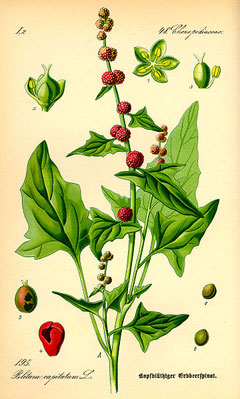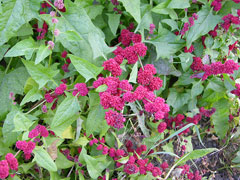 |
|
http://commons.wikimedia.org/wiki/File:Illustration_Blitum_capitatum0.jpg |
 |
| http://commons.wikimedia.org/wiki/User:Ram-Man |
Translate this page:
Summary
Physical Characteristics

 Chenopodium capitatum is a ANNUAL growing to 0.6 m (2ft).
Chenopodium capitatum is a ANNUAL growing to 0.6 m (2ft).
See above for USDA hardiness. It is hardy to UK zone 5. It is in flower from July to August, and the seeds ripen from August to September. The species is hermaphrodite (has both male and female organs) and is pollinated by Wind.
Suitable for: light (sandy), medium (loamy) and heavy (clay) soils. Suitable pH: mildly acid, neutral and basic (mildly alkaline) soils. It cannot grow in the shade. It prefers moist soil.
UK Hardiness Map
US Hardiness Map
Synonyms
Blitum capitatum.
Habitats
Cultivated Beds;
Edible Uses
Edible Parts: Fruit Leaves Seed
Edible Uses: Colouring
Leaves - raw or cooked[27, 106]. Used like spinach[2], they are a good source of vitamins C and A[257]. The young leaves are best[85, 172, 183]. Poor quality[74]. The raw leaves have been used in salad mixtures[257], but should only be eaten in small quantities, see the notes above on toxicity. Fruit - raw or cooked[2, 27, 172]. An insipid but sweet flavour[85], they can be added to salads[183]. The fruit is about 12mm in diameter[200]. A red food colouring can be obtained from the fruit[74, 99, 172, 183]. Seed - cooked. It can be ground into a meal and mixed with cereal flours in making bread etc[161, 172]. The seed is small and fiddly, it should be soaked in water overnight and thoroughly rinsed before it is used in order to remove any saponins.
References More on Edible Uses
Medicinal Uses
Plants For A Future can not take any responsibility for any adverse effects from the use of plants. Always seek advice from a professional before using a plant medicinally.
Antiphlogistic Pectoral
The plant has been used as a lotion for treating black eyes and head bruises[257]. The juice of the seeds and an infusion of the plant has been used to treat lung congestion[257].
References More on Medicinal Uses
Now available: PLANTS FOR YOUR FOOD FOREST: 500 Plants for Temperate Food Forests and Permaculture Gardens.
An important new book from PFAF. It focuses on the attributes of plants suitable for food forests, what each can contribute to a food forest ecosystem, including carbon sequestration, and the kinds of foods they yield. The book suggests that community and small-scale food forests can provide a real alternative to intensive industrialised agriculture, and help to combat the many inter-related environmental crises that threaten the very future of life on Earth.
Read More
Other Uses
Dye
Gold/green dyes can be obtained from the whole plant[168]. A red dye is obtained from the fruit, it is used in cosmetics and as a paint[46, 257].
Special Uses
References More on Other Uses
Cultivation details
An easily grown plant, succeeding in most soils but disliking shade[1, 200]. It prefers a moderately fertile soil[200]. A very ornamental plant[74], strawberry blite has at times been cultivated for its edible leaves[61].
References Carbon Farming Information and Carbon Sequestration Information
Temperature Converter
Type a value in the Celsius field to convert the value to Fahrenheit:
Fahrenheit:
The PFAF Bookshop
Plants For A Future have a number of books available in paperback and digital form. Book titles include Edible Plants, Edible Perennials, Edible Trees, and Woodland Gardening. Our new book to be released soon is Edible Shrubs.
Shop Now
Propagation
Seed - sow spring in situ. Most of the seed usually germinates within a few days of sowing.
Other Names
If available other names are mentioned here
Native Plant Search
Search over 900 plants ideal for food forests and permaculture gardens. Filter to search native plants to your area. The plants selected are the plants in our book 'Plants For Your Food Forest: 500 Plants for Temperate Food Forests and Permaculture Gardens, as well as plants chosen for our forthcoming related books for Tropical/Hot Wet Climates and Mediterranean/Hot Dry Climates. Native Plant Search
Found In
Countries where the plant has been found are listed here if the information is available
Weed Potential
Right plant wrong place. We are currently updating this section.
Please note that a plant may be invasive in one area but may not in your area so it’s worth checking.
Conservation Status
IUCN Red List of Threatened Plants Status :

| Related Plants
|
| Latin Name | Common Name | Habit | Height | Hardiness | Growth | Soil | Shade | Moisture | Edible | Medicinal | Other |
| Chenopodium acuminatum | | Annual | 0.6 |
-
| | LMH | N | M | 2 | 0 | 1 |
| Chenopodium album | Fat Hen, Lambsquarters | Annual | 0.9 |
0-0
| | LMH | N | M | 3 | 2 | 1 |
| Chenopodium ambrosioides | Mexican Tea | Annual/Perennial | 1.0 |
7-10
| | LMH | N | M | 2 | 3 | 3 |
| Chenopodium ambrosioides anthelminticum | Wormseed | Annual/Perennial | 1.0 |
7-10
| | LMH | N | M | 2 | 3 | 2 |
| Chenopodium auricomum | Queensland Bluebush | Annual | 1.8 |
-
| | LMH | N | M | 2 | 0 | 1 |
| Chenopodium berlandieri | Southern Huauzontle, Pitseed goosefoot, Nuttall's goosefoot, Bush's goosefoot, Zschack's goosefoot | Annual | 1.2 |
0-0
| | LMH | N | M | 2 | 0 | 1 |
| Chenopodium bonus-henricus | Good King Henry | Perennial | 0.3 |
4-8
| | LMH | N | M | 4 | 2 | 1 |
| Chenopodium botrys | Jerusalem Oak, Jerusalem oak goosefoot | Annual | 0.6 |
0-0
| | LMH | N | M | 2 | 2 | 2 |
| Chenopodium bushianum | Bush's goosefoot | Annual | 0.6 |
0-0
| | LMH | N | M | 2 | 0 | 1 |
| Chenopodium californicum | California Goosefoot | Annual | 0.6 |
-
| | LMH | N | DM | 2 | 1 | 2 |
| Chenopodium canihua | | Annual | 0.0 |
-
| | LMH | N | M | 2 | 0 | 1 |
| Chenopodium cristatum | Crested Goosefoot | Annual | 0.6 |
-
| | LMH | N | M | 2 | 1 | 1 |
| Chenopodium ficifolium | Fig-Leaved Goosefoot | Annual | 0.9 |
4-8
| | LMH | N | M | 2 | 0 | 1 |
| Chenopodium foliosum | Leafy goosefoot | Annual | 0.6 |
4-8
| | LMH | N | M | 3 | 0 | 1 |
| Chenopodium fremontii | Goosefoot, Fremont's goosefoot, Pringle's goosefoot | Annual | 0.6 |
0-0
| | LMH | N | M | 2 | 0 | 1 |
| Chenopodium giganteum | Tree Spinach | Annual | 2.4 |
4-8
| | LMH | N | M | 3 | 0 | 2 |
| Chenopodium glaucum | Oak-Leaved Goosefoot | Annual | 0.3 |
-
| | LMH | N | M | 2 | 0 | 1 |
| Chenopodium graveolens | Foetid Goosefoot | Annual | 0.9 |
-
| | LMH | N | M | 2 | 1 | 1 |
| Chenopodium hybridum | | Annual | 1.5 |
-
| | LMH | N | M | 2 | 1 | 1 |
| Chenopodium incanum | Mealy Goosefoot | Annual | 0.5 |
-
| | LMH | N | M | 2 | 0 | 1 |
| Chenopodium leptophyllum | Narrow Leaved Goosefoot | Annual | 0.6 |
0-0
| | LMH | N | M | 2 | 0 | 1 |
| Chenopodium murale | Nettleleaf Goosefoot | Annual | 0.6 |
0-0
| | LMH | N | M | 2 | 0 | 1 |
| Chenopodium nuttalliae | Huauzontle, Nuttall's goosefoot | Annual | 0.6 |
0-0
| | LMH | N | M | 4 | 0 | 1 |
| Chenopodium opulifolium | Seaport goosefoot | Annual | 0.8 |
0-0
| | LMH | SN | M | 2 | 0 | 1 |
| Chenopodium overi | Over's goosefoot | Annual | 0.8 |
0-0
| | LMH | N | M | 2 | 0 | 1 |
| Chenopodium pallidicaule | Cañihua | Annual | 0.6 |
-
| | LMH | N | DM | 3 | 0 | 1 |
| Chenopodium polyspermum | All-Seed, Manyseed goosefoot | Annual | 0.9 |
0-0
| | LMH | N | M | 2 | 0 | 1 |
| Chenopodium pratericola | Desert Goosefoot | Annual | 1.0 |
-
| | LMH | N | M | 2 | 0 | 1 |
| Chenopodium quinoa | Quinoa, Goosefoot, Pigweed, Inca Wheat | Annual | 1.5 |
10-12
| F | LMH | N | M | 5 | 0 | 2 |
|
|
Growth: S = slow M = medium F = fast. Soil: L = light (sandy) M = medium H = heavy (clay). pH: A = acid N = neutral B = basic (alkaline). Shade: F = full shade S = semi-shade N = no shade. Moisture: D = dry M = Moist We = wet Wa = water.

Expert comment
Author
(L.)Asch.
Botanical References
200
Links / References
For a list of references used on this page please go here
Readers comment